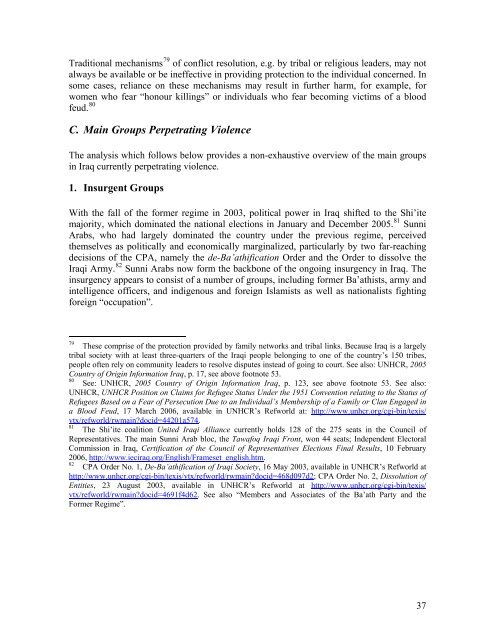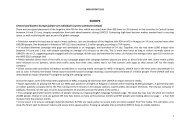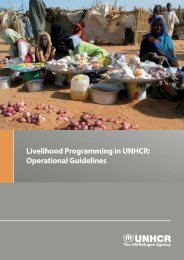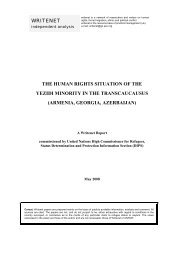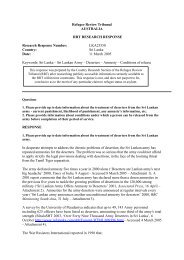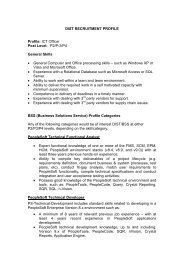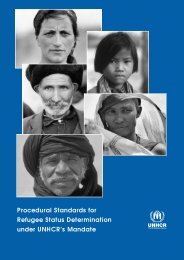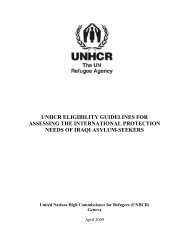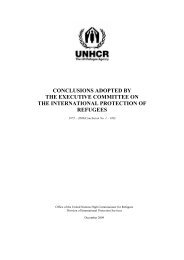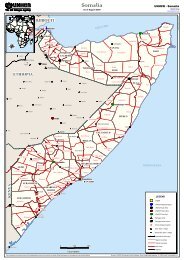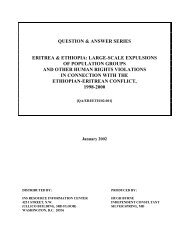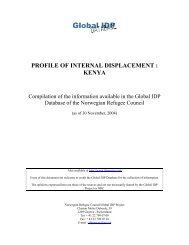UNHCR's ELIGIBILITY GUIDELINES FOR ASSESSING THE ...
UNHCR's ELIGIBILITY GUIDELINES FOR ASSESSING THE ...
UNHCR's ELIGIBILITY GUIDELINES FOR ASSESSING THE ...
Create successful ePaper yourself
Turn your PDF publications into a flip-book with our unique Google optimized e-Paper software.
Traditional mechanisms 79 of conflict resolution, e.g. by tribal or religious leaders, may not<br />
always be available or be ineffective in providing protection to the individual concerned. In<br />
some cases, reliance on these mechanisms may result in further harm, for example, for<br />
women who fear “honour killings” or individuals who fear becoming victims of a blood<br />
feud. 80<br />
C. Main Groups Perpetrating Violence<br />
The analysis which follows below provides a non-exhaustive overview of the main groups<br />
in Iraq currently perpetrating violence.<br />
1. Insurgent Groups<br />
With the fall of the former regime in 2003, political power in Iraq shifted to the Shi’ite<br />
majority, which dominated the national elections in January and December 2005. 81 Sunni<br />
Arabs, who had largely dominated the country under the previous regime, perceived<br />
themselves as politically and economically marginalized, particularly by two far-reaching<br />
decisions of the CPA, namely the de-Ba’athification Order and the Order to dissolve the<br />
Iraqi Army. 82 Sunni Arabs now form the backbone of the ongoing insurgency in Iraq. The<br />
insurgency appears to consist of a number of groups, including former Ba’athists, army and<br />
intelligence officers, and indigenous and foreign Islamists as well as nationalists fighting<br />
foreign “occupation”.<br />
79 These comprise of the protection provided by family networks and tribal links. Because Iraq is a largely<br />
tribal society with at least three-quarters of the Iraqi people belonging to one of the country’s 150 tribes,<br />
people often rely on community leaders to resolve disputes instead of going to court. See also: UNHCR, 2005<br />
Country of Origin Information Iraq, p. 17, see above footnote 53.<br />
80 See: UNHCR, 2005 Country of Origin Information Iraq, p. 123, see above footnote 53. See also:<br />
UNHCR, UNHCR Position on Claims for Refugee Status Under the 1951 Convention relating to the Status of<br />
Refugees Based on a Fear of Persecution Due to an Individual’s Membership of a Family or Clan Engaged in<br />
a Blood Feud, 17 March 2006, available in UNHCR’s Refworld at: http://www.unhcr.org/cgi-bin/texis/<br />
vtx/refworld/rwmain?docid=44201a574.<br />
81 The Shi’ite coalition United Iraqi Alliance currently holds 128 of the 275 seats in the Council of<br />
Representatives. The main Sunni Arab bloc, the Tawafoq Iraqi Front, won 44 seats; Independent Electoral<br />
Commission in Iraq, Certification of the Council of Representatives Elections Final Results, 10 February<br />
2006, http://www.ieciraq.org/English/Frameset_english.htm.<br />
82 CPA Order No. 1, De-Ba’athification of Iraqi Society, 16 May 2003, available in UNHCR’s Refworld at<br />
http://www.unhcr.org/cgi-bin/texis/vtx/refworld/rwmain?docid=468d097d2; CPA Order No. 2, Dissolution of<br />
Entities, 23 August 2003, available in UNHCR’s Refworld at http://www.unhcr.org/cgi-bin/texis/<br />
vtx/refworld/rwmain?docid=4691f4d62. See also “Members and Associates of the Ba’ath Party and the<br />
Former Regime”.<br />
37


